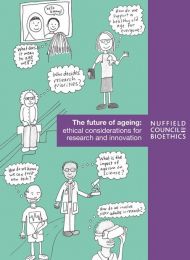The future of ageing
Report
Published 25/04/2023

This report sets out an ethical framework and recommendations for research and innovation related to ageing.
Design and conduct of research studies related to ageing
Benefits and harms
A key ethical question in any field of research is that of the relationship between likely benefits and possible harms. Research and innovation in the field of ageing covers a very broad spectrum of approaches, each raising different considerations with respect to benefit and harm.
- Geroscience research seeks to intervene in common hallmarks of ageing in ways that, in the long-term, could delay the onset of, or even prevent, a number of conditions associated with ageing. Significant success in this field could make an important contribution to healthy life expectancy for future generations, particularly given the current impact on older people of receiving multiple treatments for multiple conditions, and the associated risks of polypharmacy. Concerns have been expressed, however, over the risk of hype – not least in the language of finding a ‘cure for ageing’. Given the challenges of translating research findings in animals to humans, it will be important to be realistic about likely timescales for such interventions. More immediate benefits may be more likely to arise through the translation of our increased understanding of the hallmarks of ageing into novel treatments for single conditions such as age-related macular degeneration and diabetic retinopathy.
- Many developments in communication and assistive technologies are self-evidently beneficial, providing convenience and increased safety for older people who can choose how and when to make use of them. However, risks in their use might include devices being marketed / used inappropriately, so that the person loses capacities that could have been regained rather than compensated for; depersonalisation and loss of the human touch and engagement implicit in the notion of ‘caring’; or technologies used to control rather than empower and support older people.
- Developments in diagnostics, arising, for example, from data-driven research including the use of AI techniques, or the identification of new biomarkers, offer prospect of earlier identification either of some of the common diseases of ageing, or of risk factors for these conditions. Success in this area would offer scope for important benefits in cases where effective preventative measures or treatments were available. Risks include diagnosis without access to a subsequent action plan or effective treatment; over-medicalisation of middle and later life; and increasing rates of polypharmacy.
A common challenge across all three broad fields described above is that of equity, and the need to ensure that those who are already disadvantaged with respect to their health have equal access to any such benefits.
Question 5
Please comment on the likely benefits, and possible harms, of developments in the area of ageing research with which you are familiar.
Issues you might wish to touch on in your response include (but need not be limited to):
- the kind of timeframe (1, 5, 10, 20, 30 years?) in which you envisage benefits becoming available;
- what form those benefits might take, at whom they are targeted (e.g., older people now, future cohorts of older people, professionals, family carers?) – and how widely accessible they are likely to be to diverse users / patients;
- any harms that you think might be associated with these developments – and how these might be mitigated;
- what action might need to be taken to help ensure that developments in your field contribute to reducing existing inequalities, rather than potentially adding to them;
- any implications for sustainability, whether of the environment or of existing systems.
Codesign and coproduction of research
There is an increasing recognition of the value of future users of research and innovation being involved not only in prioritising research aims but also in the design and conduct of studies. In the context of ageing research, this potentially involves partnerships both with older people, and with younger generations, who may be the ones most affected by developments in earlier diagnosis or earlier intervention in the diseases associated with ageing.
Examples of existing partnerships between researchers and older people in the UK include:
- the Age Innovation Hub at University College London which invites older people to submit ideas “around “everyday annoyances or pains technology could help with”; and then help co-create solutions;
- The 1000 Elders group at the University of Birmingham which brings together researchers and older people to work on healthy ageing –from identifying research priorities, to piloting aspects of a study, commenting on participant literature, and participating as healthy controls;
- an initiative at the University of Stirling in which older people are collaborating with builders, architects, and housing providers with the aim of identifying designs that could support healthy cognitive ageing;
- The National Innovation Centre for Ageing in Newcastle who engaged with volunteers from age 11 up to brainstorm approaches to a ‘four generational kitchen’ that would support multi-generational living.
Question 6
Please comment on the role of older people, and of intergenerational public input, in helping shape research and innovation directed towards the needs of current and future older populations.
Issues you might wish to touch on in your response include (but need not be limited to):
- providing examples of ways that older people, and/or members of the public of all ages, have been involved in the design and conduct of studies, and how this has affected the study and findings;
- identifying the challenges of taking this kind of approach, and how these might be overcome (or why, in your view, this kind of participative approach to research is not appropriate in your particular field);
- consideration of how the voices of those who tend to be underrepresented or marginalised can be heard, and their needs and experiences incorporated in research design and conduct.
Recruitment criteria
Older people are widely excluded from participating in trials of medicines or other interventions that could potentially be of benefit to them. This may mean that older people are subsequently unable to benefit from interventions that are shown to work in younger people. Alternatively, where interventions are licensed for everyone on the basis of studies only in younger people, older people and those living with other conditions may be exposed to unknown risks, because of the lack of knowledge as to how the new intervention might affect their other conditions, or interact with other medications.
Such exclusion criteria in research may be direct, through specific age restrictions; or indirect, for example through exclusion of anyone living with other long-standing conditions. They may be based on specific safety concerns, or arise incidentally: for example through non-medical recruitment requirements that older people are less likely to meet, or through ‘gatekeeper’ influence whereby older people are not approached in the first place.
Setting meaningful and inclusive recruitment criteria represents a specific challenge in geroscience research: as studies move from animal models to humans, should they target those who already have age-related conditions, or should they be working with younger generations with the aim of intervening early? (See also Regulatory challenges below.)
Question 7
How can older people be better represented in clinical trials that are of potential relevance to them?
Issues you might wish to touch on in your response include (but need not be limited to):
- providing examples of barriers in your field, and how these might be overcome;
- the implications of under-representation of older people in trials – and of equality of representation within the older population;
- any particular issues relating to appropriate recruitment criteria for geroscience research;
- the advantages and disadvantages of introducing regulatory incentives to promote the routine involvement of older people in studies relevant to their health (for example on the lines of existing requirements in the UK and EU to develop ‘paediatric investigation plans’ for research that could potentially benefit children).
Regulatory challenges
A number of regulatory challenges arise in connection with specific areas of ageing research and innovation. While some of these challenges are primarily technical in nature (for example the use of proxy endpoints for research where benefits are likely to accrue a long way in the future), the way that regulatory questions are tackled often has ethical implications.
Geroscience research
The timescales involved in research into biological ageing are much longer than in most fields of science. This raises challenging regulatory questions: relating first to the identification of meaningful endpoints for studies (what constitutes ‘success’ in the short or mid-term); and second to how research findings might translate into licensable products. Current regulatory systems are designed around single conditions, with medications licensed for named ‘indications’. A novel intervention that targeted a single ageing pathway involved in multiple conditions would at present need to seek licensing authorisation for each of these conditions separately.
One proposed solution to this challenge is that of classifying ‘ageing’ itself as a disease, so that interventions could be measured for their capacity to influence one or more of the hallmarks of ageing. Another innovative approach has been put forward in the Targeting Aging with Metformin (TAME) study which aims to measure whether metformin can delay the onset of any one of a number of age-related conditions including stroke, heart failure, dementia and cancer – thus aiming to use a composite, rather than single disease, endpoint.
Technological innovation
A particular challenge in the technological field is the very unclear dividing line between technologies and devices developed for lifestyle (or ‘wellness’) purposes, and those designed specifically for medical purposes. In practice, it seems likely that these purposes will increasingly be blurred, as we use lifestyle devices to monitor our own health, and health and care providers make greater use of generalist digital services. However, at present, distinctly different regulatory regimes apply to the authorisation and marketing of devices, depending on how they are classified.
Question 8
Please comment on the ethical aspects of the regulatory challenges raised by the field of ageing research with which you are familiar.
Issues you might like to touch on in your response include (but need not be limited to):
- whether, for regulatory purposes, ‘ageing’ should be classified as a disease – and any ethical implications of this;
- any alternative approaches to the regulatory challenges of interventions based on geroscience – and any associated ethical implications;
- how assistive and connective technologies that may be used to support older people should be regulated, and the ethical implications of preferred approaches.

Share